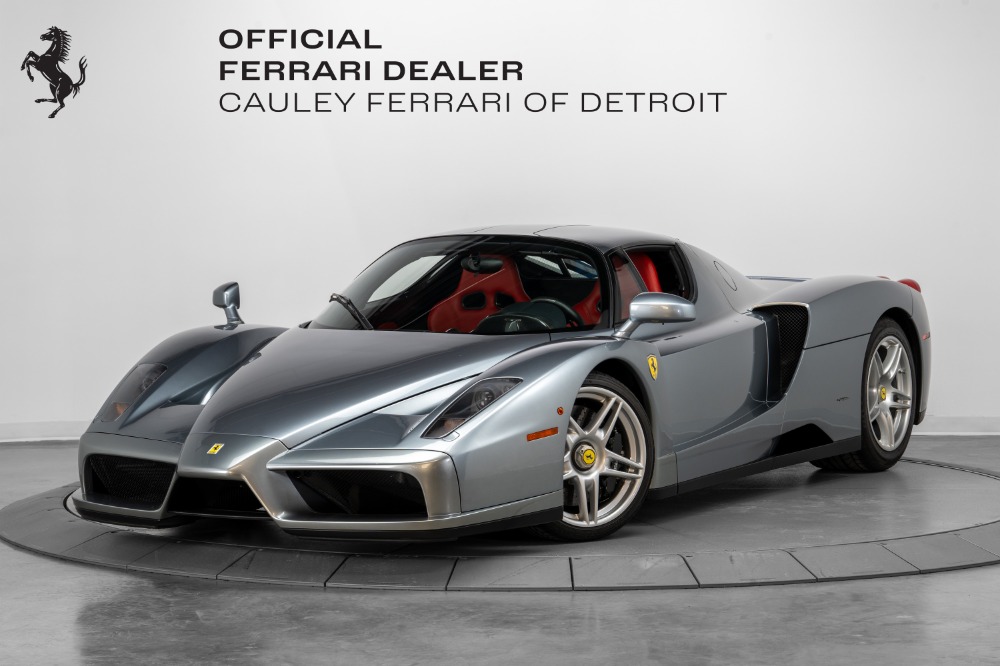


2003 Ferrari Enzo
Our Price:
SOLD
| Exterior Color | Grigio Titanio |
| Interior Color | Rosso |
| Odometer: | 3,025Mi |
| Bodystyle: | Coupe |
| Engine: | 6.0L NA V12 double overhead cam (DOHC) 48V |
| Transmission: | 6-Speed Automated Manual |
| VIN: | ZFFCW56A830135872 |
| Stock #: | FP2350 |
| Type: | Used |




































































































Description
Cauley Ferrari is beyond thrilled to offer this stunning one-of-one 2003 Ferrari Enzo finished in Grigio Titanio over Rosso. This is an all-original example that is in outstanding condition. A full service was recently completed and this Enzo is being sold as a Ferrari Classiche vehicle. The Enzo's vehicle history can be seen below.A USA-specification Enzo that was ordered by 250 GTO owner and Ferrari SpA VIP client Chip Connor who resided in three different countries at the time. He chose the selling dealer to be Meridian Modena Limited in England. The car remained in Europe only for a short time (1-2 months) before being sent to the USA and is believed to have remained in the US ever since.
- 2003 Ferrari Enzo finished in the one-off livery of beautiful Grigio Titanio (factory code 3238 140) over Pelle Rosso (factory code 112806).
- ZFFCW56A830135872, engine number 80775, gearbox number 313, body number 116, assembly number 52895.
- The factory build commenced on 12th of December 2003 and concluded on 30th of April 2004.
- All Books and luggage accompany the vehicle.
- The factory build commenced on 12th of December 2003 and concluded on 30th of April 2004.
- All Books and luggage accompany the vehicle.
Upon factory completion, Connor himself collected the Enzo directly from the Maranello factory on Italian Touring plates EE.497.BP. The vehicle was later imaged by Marcel Massini at Laguna Seca raceway, in August 2004, still wearing said EE plates. Subsequent to Connor's ownership, 135872 was sold in 2012 to a Beverly Hills collector. During his stewardship, the Enzo was entered in the Cavallino Classic in 2013, where it won the Supercar Cup Award. The car also appeared in the book 'Ferrari Hypercars' by Winston Goodfellow (back cover and interior pages 207, 208 and 209). Thereafter, it was sold in 2013 to a Dallas collector, and then to the current owner.This Enzo is presented with a clean USA title. There are no cosmetic modifications applied to the vehicle whatsoever, other than paint protection film (PPF) which covers the front bumper and wheel-well arches.
The Ferrari Enzo, unveiled in 2002, stands as an emblem of Ferraris relentless pursuit of automotive excellence. This supercar, named in honor of the companys founder, Enzo Ferrari, integrates Formula 1 technology into a road car, epitomizing a unique synthesis of performance and design. Powered by a 6.0-liter V12 engine, it generates 651 horsepower, propelling it from 0-60 mph in just 3.14 seconds. Its aerodynamic design employs a carbon-fiber body and an active aero system, dynamically adjusting for optimal downforce.
By 2002, Luca di Montezemolo, then serving as Ferraris president, unveiled the answer: the imminent Ferrari Enzo. The nomenclature wasnt mere serendipity. Di Montezemolo deemed it apt to christen the vehicle after the companys luminary founder, considering previous models were named after significant locations like Maranello and Modena. Furthermore, he accentuated the vehicles intrinsic link to Formula One, highlighting Ferraris consecutive victories in the Manufacturers Championships (1999-2001) and Drivers Championships (2000-2001). Concurrently, Michael Schumacher was scripting an unparalleled narrative in F1, amassing an unrivaled five successive championships.
The Ferrari Enzo made its grand appearance at the 2002 Paris Motor Show, epitomizing avant-garde engineering. Mirroring an F1 vehicle, the Enzo incorporated state-of-the-art materials to optimize weight efficiency. Its primary chassis tub, constructed from a composite of carbon fiber and Nomex honeycomb, tipped the scales at a mere 200 pounds. Aluminum sub-structures were juxtaposed onto this tub, serving as a precursor for the subsequent attachment of the distinctive Pininfarina-conceived exterior.
Crafted by the adept hands of Pininfarinas Ken Okuyama, the Enzos silhouette evoked the aesthetics of an open-wheel racer, albeit enveloped in a seamless exoskeleton. Perfected aerodynamics, achieved within Pininfarinas wind tunnel, showcased a body featuring panels synthesized from carbon fiber and Kevlar. Complementing this ensemble were 19-inch alloy wheels, fortified by 15-inch Brembo carbon-ceramic disc brakes and punctuated by signature scissor doors, culminating in a technologically advanced masterpiece.
Nestled behind the cockpit was a revolutionary engine, perpetuating the manufacturers iconic configuration for elite sportscars. A modified 90-degree V-8, augmented by an additional pair of cylinders on either flank and a revised angle, gave birth to the 65-degree Tipo F140B V-12 powerhouse. With a displacement nearing six liters, the F140 emerged as Maranellos most formidable engine since the epoch of the 712 Can-Am racer in the 1970s. Infused with performance-enhancing elements like Nikasil-coated cylinders, titanium conrods, and a dynamic intake manifold, the engine boasted an astounding 651 horsepower and 485 pound-feet of torque. Remarkably, the F140s lineage would subsequently breathe life into successors like the 599 series, F12berlinetta, and the transcendent LaFerrari.
